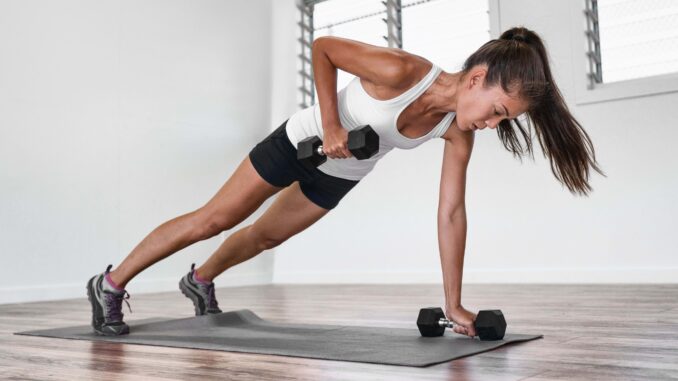
In the realm of fitness, where time is a precious commodity, High-Intensity Interval Training (HIIT) emerges as a powerhouse, promising maximum results in minimal time. This comprehensive guide explores the intricacies of HIIT, unraveling its benefits, techniques, and the science behind its efficacy in sculpting bodies and enhancing overall fitness.
I. Understanding HIIT
A. Defining High-Intensity Interval Training
- Dynamic Work and Rest Cycles: HIIT involves alternating between short bursts of intense exercise and brief periods of rest or low-intensity activity.
- Versatility of Exercises: From sprinting and jumping to bodyweight exercises, HIIT accommodates a variety of workouts, providing flexibility in customization.
B. The Science Behind HIIT
- EPOC Phenomenon: Excess Post-Exercise Oxygen Consumption (EPOC) contributes to HIIT’s calorie-burning effectiveness, extending the metabolic boost post-workout.
- Aerobic and Anaerobic Benefits: HIIT stimulates both aerobic and anaerobic pathways, enhancing cardiovascular health and muscular endurance.
II. Benefits of HIIT
A. Efficient Caloric Burn
- Maximizing Caloric Expenditure: HIIT’s intensity leads to a higher caloric burn in a shorter time, making it an efficient choice for weight management.
- Afterburn Effect: EPOC ensures a prolonged afterburn effect, where the body continues to burn calories post-exercise.
B. Cardiovascular Health
- Improved Heart Health: HIIT improves cardiovascular function, enhancing heart health and reducing the risk of cardiovascular diseases.
- Lowering Blood Pressure: Regular HIIT sessions contribute to lowered blood pressure, promoting overall cardiovascular well-being.
C. Time-Efficient Workouts
- Shorter Workout Durations: HIIT allows individuals to achieve significant fitness gains with shorter workout durations, fitting busy schedules.
- Accessibility: Minimal equipment requirements make HIIT accessible for home workouts or on-the-go training.
III. HIIT Techniques
A. Tabata Training
- Four-Minute Intervals: Tabata involves 20 seconds of intense exercise followed by 10 seconds of rest, repeated for four minutes.
- Versatility: Applicable to various exercises, Tabata provides a structured approach to HIIT.
B. The 30/30 Method
- Equal Work and Rest: This method involves alternating between 30 seconds of intense exercise and 30 seconds of rest.
- Adaptability: Suited for beginners and advanced fitness enthusiasts alike, the 30/30 method accommodates a range of exercises.
IV. Customizing Your HIIT Workout
A. Bodyweight HIIT
- No Equipment Necessary: Bodyweight HIIT routines require minimal or no equipment, offering effective workouts without the need for a gym.
- Engaging Multiple Muscle Groups: Combining exercises like squats, burpees, and push-ups engages multiple muscle groups for comprehensive fitness.
B. Cardio HIIT
- Sprinting and Jumping: Cardio-focused HIIT integrates sprinting, jumping jacks, and other high-intensity cardio exercises for enhanced cardiovascular benefits.
- Interval Cycling: Cycling between intense pedaling and recovery periods on a stationary bike offers a low-impact yet effective cardio HIIT option.
V. HIIT and Strength Training
A. Combining HIIT with Weights
- Enhancing Muscular Strength: Incorporating weights into HIIT sessions enhances muscular strength and promotes a balanced fitness approach.
- Compound Movements: Exercises like kettlebell swings and deadlifts in HIIT sequences engage multiple muscle groups, maximizing efficiency.
VI. HIIT for Beginners
A. Gradual Progression
- Start with Low Intensity: Beginners can begin with lower-intensity exercises and gradually increase intensity as fitness levels improve.
- Adaptation Period: Allow the body time to adapt to the demands of HIIT, focusing on proper form and technique.
VII. Overcoming Challenges in HIIT
A. Injury Prevention
- Proper Warm-Up: Adequate warm-up before HIIT reduces the risk of injuries and prepares the body for intense activity.
- Listen to Your Body: Paying attention to signs of fatigue or discomfort and adjusting intensity accordingly is crucial for injury prevention.
VIII. Incorporating HIIT into Your Routine
A. Frequency and Consistency
- Balanced Approach: While HIIT offers efficiency, balance it with other forms of exercise for a well-rounded fitness routine.
- Consistency is Key: Regular, consistent HIIT sessions yield optimal results, emphasizing the importance of integrating it into a sustainable routine.
IX. Tracking Progress in HIIT
A. Performance Metrics
- Time and Intensity: Track workout duration, intensity levels, and the ability to maintain or increase effort over time.
- Body Composition Changes: Monitor changes in body composition, such as fat loss and muscle gain, to assess progress accurately.
X. The Future of Fitness: HIIT Innovations
A. Technology Integration
- HIIT Apps and Wearables: Technological advancements offer HIIT-specific apps and wearables, providing guided sessions and real-time performance tracking.
- Virtual Reality (VR) HIIT: The integration of VR in HIIT workouts offers immersive and engaging experiences, revolutionizing home-based training.
XI. Conclusion: HIIT for a Thriving Fitness Journey
As the fitness landscape evolves, HIIT stands as a dynamic and effective approach to achieving maximum results in a time-efficient manner. Its adaptability, scientific foundation, and myriad benefits make HIIT a cornerstone of thriving fitness journeys. Whether you’re a seasoned